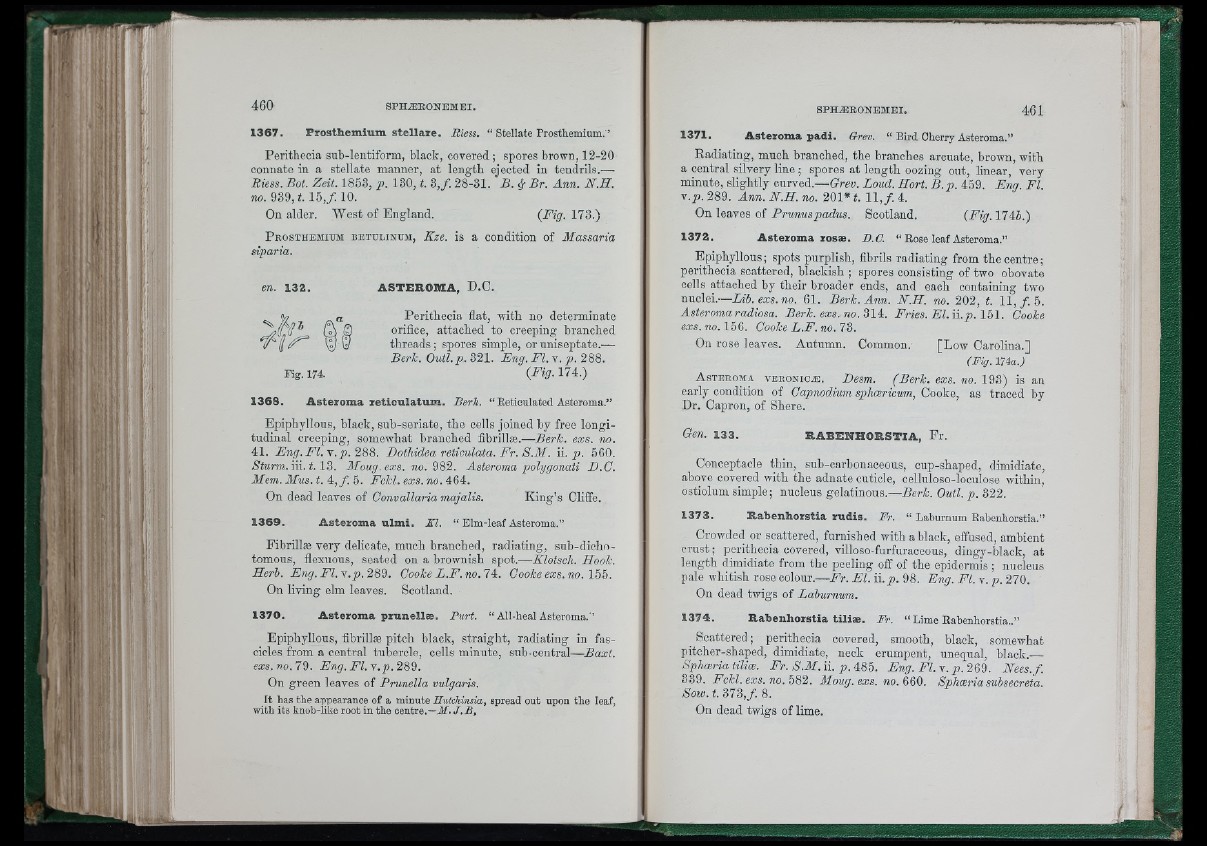
1 3 6 7 . P ro s th em ium s t e lla r e . Bless. “ Stellate Prosthemium. ’
Perithecia sub-lentiform, black, covered ; spores brown, 12-20
connate in a stellate manner, at length ejected in tendrils.—
Biess. Bot. Zeit. 1853, p . 130, t. 3 ,/. 28-31. B . / Br. Ann. N.H .
no. 939, t. 15 ,/. 10.
On alder. West of England. {Fig- 173.)
P kosthemium bbtulinum, Kze. is a co n d itio n o f Massaria
siparia.
en. 1 3 2 .
Mg. 174.
AST EROMA , B.C.
Perithecia flat, witb no determinate
orifice, attached to creeping branched
threads; spores simple, or nniseptate.—
Berk. Outl.p. 321. Eng. Fl. v. p . 288.
{Fig. 174.)
1 3 6 8 . A s te r om a r e t ic u la tum . Berk. “ Eetioulated Asteroma.”
Epipbyllous, black, sub-seriate, tbe cells joined by free longitudinal
creeping, somewbat branched fibrillæ.—Berk. exs. no.
41. E n g .F l. r .p . 288. Dothidea reticulata. Pr. S.M. ii. p. 560.
Niam.iii. i. 13. Moug. exs. no. 982. Asteroma polygonati D.C.
Mem. Mus. t. 4 , / 5. Fckl. exs. no. 464.
On dead leaves of Convallaria majalis. King’s Cliffe.
1 3 6 9 . A s te r om a u lm i. S I . “ Elm-leaf Asteroma.”
Fibrillte very delicate, much branched, radiating, snb-dicho-
tomous, flexuous, seated on a brownish spot.—Klotsch. Hook.
Herh. E n g .F I .y .p .2 8 9 . Cooke L .F . no. 7 4. Coohe exs.no. 155.
On living elm leaves. Scotland.
1 3 7 0 . A ste rom a p ru n e llæ . Purt. “ All-heal Asteroma.”
Epipbyllous, fibrillse pitch black, straight, radiating in fascicles
from a central tubercle, cells minute, sub-central—Baxt.
exs. no.79. Evg. F I .y .p . 289.
On green leaves of Prunella vulgaris.
I t has the appearance of a minute Hutchinda, spread out upon the leaf,
with its knob-like root in the centre.—i f . J. B ,
13 7 1 . A ste rom a p ad i. Orev. “ Bird Cherry Asteroma.”
Eadiating, much branched, the branches arcuate, brown, witb
a central silvery line ; spores at length oozing out, linear, very
minute, slightly curved.— Grev. Loud. Hort. B .p . 459. Eng. Fl.
Y.p. 289. Ann. N .H . no. 201* t. 11, f . 4.
On leaYes of Frunuspadus. Scotland. (Fig.l74h.)
1 3 7 2 . A ste rom a zosæ. D.O. “ Rose leaf Asteroma.”
Epipbyllous; spots purplish, fibrils radiating from the centre;
perithecia scattered, blackish ; spores consisting of two obovate
cells attached by their broader ends, and eacb containing two
nuclei.—Lib.exs.no. 61. Berh. Ann. N .H . no. 202, t. 1 1 , / 5 .
Asteroma radiosa. Berh. exs. no. 314. Fries. El. ii.p. 151. Coohe
exs.no. 156. Coohe L .F . no. 73.
On rose leaves. Autumn. Common. [Low Carolina.]
(Fig. 174a.)
A steroma vbronioiE. Desm. (Berk. exs. no. 198) is an
early condition of Capnodium sphcericum, Cooke, as traced by
Dr. Capron, of Sbere.
Gen. 1 3 3 . R A B E N H O R ST IA , Er.
Conoeptacle thin, sub-carbonaceous, cup-sbaped, dimidiate,
above covered witb the adnate cuticle, celMoso-loculose within,
ostiolum simple; nucleus gelatinous.—Berh. Outl. p. 322.
1 3 7 3 . R a b en h o z stia z u d is. Fr. “ Laburnum Kabenhorstia.”
Crowded or scattered, furnished with a black, effused, ambient
c ru s t; peritheoia covered, villoso-furfuraoeous, dingy-black, at
length dimidiate from tbe peeling off of the epidermis ; nucleus
pale whitish rose colour.—Dr. E l. ii.p . 98. Eng. Fl. v. p. 270.
On dead twigs of Laburnum.
1 3 7 4 . R a b en h o z stia t iliæ . Fr. “ Lime Rabenhorstia..”
^ Scattered ; perithecia covered, smooth, black, somewbat
pitoher-sbaped, dimidiate, neck erumpent, unequal, black.—
Sphoeria tilicB. Fr. S .M .ii. p. 485. Eng. F I .y . p . 269. Nees.f.
339. Fchl. exs. no. 582. Moug. exs. no. 660. Sphoeria subsecreta
Sow. t. 373, f . 8.
On dead twigs of lime.